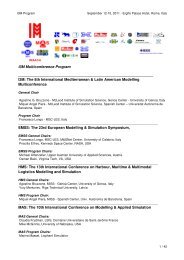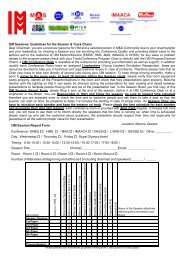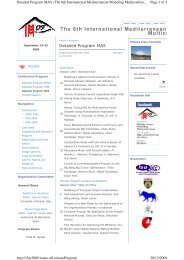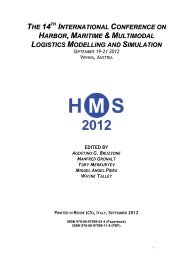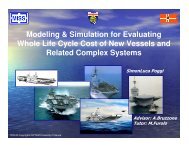HMS2006_F1 - Liophant Simulation
HMS2006_F1 - Liophant Simulation
HMS2006_F1 - Liophant Simulation
Create successful ePaper yourself
Turn your PDF publications into a flip-book with our unique Google optimized e-Paper software.
Storage<br />
areas<br />
Road transport<br />
area<br />
Recept./depart.<br />
tracks<br />
Gantry crane,<br />
reachstackers<br />
Tracks for<br />
loading/unloading<br />
Consolidation<br />
center<br />
Figure 2. Screenshot of the model’s display window<br />
In particular, on average a train is shipped<br />
everyday to every destination and a train arrives<br />
every day from every origin, but on Sundays,<br />
where trains neither arrive nor depart.<br />
Destination/origin points are the ports located<br />
in Valencia, Bilbao, Barcelona y Algeciras.<br />
As to the train length, the number of containers<br />
can not exceed a maximum number.<br />
However, if the train is due to leave and if the<br />
number of already loaded containers is greater<br />
than a lower bound, it is allowed to depart even<br />
if it does not contain its maximum load. If the<br />
minimum loading condition applies but first<br />
condition does not, the train is allowed to<br />
depart as soon as it does.<br />
Loading and unloading of containers onto the<br />
flat wagons are preferably carried on with the<br />
gantry crane, though if necessary reachstackers<br />
can be used as well.<br />
Loading operations are considered to be of a<br />
higher priority than unloading ones, in order to<br />
allocate resources when conflicts arise. The<br />
loading process is launched at around two hours<br />
in advance of the planned depart time and is<br />
finished twenty minutes before that time. From<br />
that moment on, no loading of the train is<br />
allowed.<br />
With regard to the containers coming from road<br />
transport, there is an unloading area where<br />
trucks park. Mobile cranes move to that area<br />
where trucks are unloaded. The container is<br />
carried either to the loading area (if its priority<br />
is urgent) or to the storage area (which occurs<br />
in most cases).<br />
Those trucks arriving to the dry port and whose<br />
destination point is Madrid are loaded with a<br />
mobile crane, in the unloading area.<br />
Those containers to be loaded to a truck (for<br />
regional delivery) can proceed from any of the<br />
following three sources: a recently unloaded<br />
container, the storage area or, finally, the<br />
consolidation/deconsolidation centre. In terms<br />
of the model, an attribute contained the value<br />
describing the origin of each container.<br />
Finally, the stochastic nature of the model is<br />
embedded, mainly, in the following elements.<br />
First, there is probability according to which<br />
containers are labelled as urgent; the number of<br />
containers that ought to undergo a<br />
redistribution process; and the failure rate of<br />
cranes involved in the loading/unloading<br />
operations.<br />
The image in figure 2 is a screenshot from the<br />
display of the model, where the most relevant<br />
components of the model can be identified.



